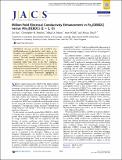Million-Fold Electrical Conductivity Enhancement in Fe[subscript 2](DEBDC) versus Mn[subscript 2](DEBDC) (E = S, O)
Author(s)
Sun, Lei; Hendon, Christopher H.; Walsh, Aron; Minier, Mikael Antoine; Dinca, Mircea
DownloadSun-2015-Million-fold electrical.pdf (2.362Mb)
PUBLISHER_POLICY
Publisher Policy
Article is made available in accordance with the publisher's policy and may be subject to US copyright law. Please refer to the publisher's site for terms of use.
Terms of use
Metadata
Show full item recordAbstract
Reaction of FeCl[subscript 2] and H[subscript 4]DSBDC (2,5-disulfhydrylbenzene-1,4-dicarboxylic acid) leads to the formation of Fe[subscript 2](DSBDC), an analogue of M[subscript 2](DOBDC) (MOF-74, DOBDC[superscript 4–] = 2,5-dihydroxybenzene-1,4-dicarboxylate). The bulk electrical conductivity values of both Fe2(DSBDC) and Fe[subscript 2](DOBDC) are ~6 orders of magnitude higher than those of the Mn[superscript 2+] analogues, Mn[subscript 2](DEBDC) (E = O, S). Because the metals are of the same formal oxidation state, the increase in conductivity is attributed to the loosely bound Fe[superscript 2+] β-spin electron. These results provide important insight for the rational design of conductive metal–organic frameworks, highlighting in particular the advantages of iron for synthesizing such materials.
Date issued
2015-05Department
Massachusetts Institute of Technology. Department of ChemistryJournal
Journal of the American Chemical Society
Publisher
American Chemical Society (ACS)
Citation
Sun, Lei, Christopher H. Hendon, Mikael A. Minier, Aron Walsh, and Mircea Dinca. “Million-Fold Electrical Conductivity Enhancement in Fe[subscript 2](DEBDC) Versus Mn[subscript 2](DEBDC) (E = S, O).” Journal of the American Chemical Society 137, no. 19 (May 20, 2015): 6164–6167. © 2015 American Chemical Society
Version: Final published version
ISSN
0002-7863
1520-5126